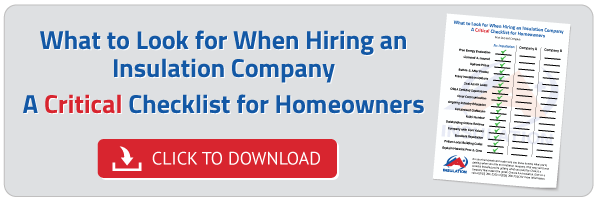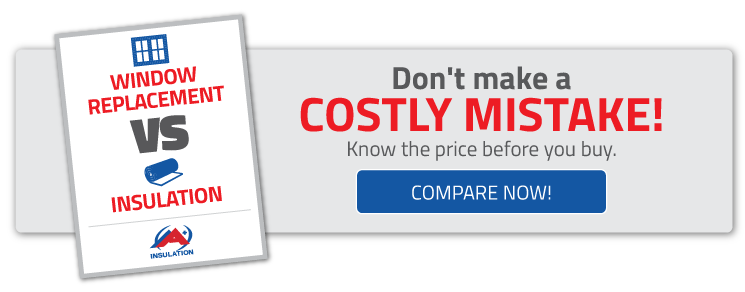As winter quickly approaches and settles in, we familiarize ourselves once again with the routine of heating our homes and paying that dreaded energy bill. We all are extremely eager to reduce that monthly expense and A+ Insulation is here to help!
Efficient energy use is important year-round, but even more so in the winter months. In addition to insulation installation, there are numerous simple energy-saving actions that one can take to reduce energy bills this winter. Outlined below are various inexpensive tips and investment-based steps that can help save you money:
11+ Inexpensive Ways to Lower Your Heating Bills
Turn Down Your Thermostat
While 72 degrees may feel best, you can turn your thermostat down to 68 degrees and wear a sweater to feel warmer. For every degree you lower it, you’ll save up to 5% on heating costs. If you don’t have a programmable thermostat, it’s a worthwhile investment that allows you to automatically control your home’s temperature at different times of the day.
Seal Leaks to Stop Heat from Escaping
Windows and doors are the most obvious places that need caulking and weather stripping. But don’t forget to check for pipes that travel through a wall like under sinks, near appliances, and in closets. Caulk works best for small openings while expanding foam may be better for large gaps.
Lower the Temperature on Your Water Heater
Heating your water costs energy and money too. Lower your water heater to 120 degrees and you could save 7-11% on your water heating costs.
Insulate Your Water Heater
Save up to 10% on water heating costs by wrapping your water heater’s tank with insulation, especially if it’s an older model, which will have minimal internal insulation. If it’s a gas water heater, be sure to leave the air intake vent uncovered.
Replace Your Furnace Filter
Making sure your furnace filter is clean will help your furnace run more efficiently. A tune-up is also a good idea as a clean, lubricated, and properly adjusted furnace will save up to 5% of heating costs.
Open Drapes and Blinds on Sunny Days
Take advantage of the sun’s natural power to heat your home. Let it shine in your windows during the day and close the blinds or curtains once the sun goes down to keep heat from escaping.
Check Your Fireplace Damper
An unlit fireplace is basically an escape route for heat. Make sure your damper is tightly closed when not in use. Keeping your damper closed can prevent as much as 8% of your heated air from going up the chimney.
Don’t Leave Exhaust Fans On
It may seem like a small thing, but when left running, kitchen and bathroom exhaust fans can blow out a house full of heated air in a short time.
Shorten Showers
Did you know that showers account for about 2/3 of your water heating costs? Cutting your showers in half will reduce your water heating costs by about a third.
Install Low-Flow Showerheads
Low-flow showerheads and faucets can reduce your hot water expenses. You’ll save 10-16% on water heating costs.
Replace Light Bulbs
Replace your old incandescent bulbs with Energy Star compact fluorescent light (CFL) bulbs. Compact fluorescent lights use 75% less energy than incandescent lights.
Small Things That Pay Off Over Time
While these things won’t make a huge impact on their own, done consistently over time, they will help you reduce your energy use:
- Turn off lights
- Use the cold water setting on your washer when possible and reduce its energy use by 75%
- Clean the lint trap regularly on your dryer
- Use the energy saver mode on your computer(s)
- Eliminate “vampire” energy or standby loss by unplugging electronics and chargers when not in use and switching off energy strips
- Unplug the extra fridge if you don’t need it as it can add 10-25% to your electric bill
5 Investments That Will Lower Your Heating Bills
Replace Appliances with Energy Star Models
If you need new appliances, be sure to purchase Energy Star certified products like furnaces, air conditioners, refrigerators, water heaters, etc. Energy Star rated appliances and also electronic products use significantly less energy to do the job. For example, a new Energy Star washing machine uses half the energy of a standard washing machine.
Install a Programmable Thermostat
Besides making sure your home is comfortable, a programmable thermostat can save up to 15% on energy costs.
Increase Ceiling Insulation
If your ceiling is uninsulated or scantily insulated, consider increasing your insulation to up to R-38 to reduce heating costs by 5-25%.
Seal Your Ducts
Leaking ductwork accounts for more than 25% of heat loss. Consider hiring a contractor like A+ Insulation for duct sealing. We can test your ducts and repair leaks and restrictions in your ductwork.
Install Energy Efficient Windows
Choosing Energy Star windows can reduce your heating and cooling costs by up to 15%.
As temperatures begin to drop we are reminded how important it is to keep the heat in and the cold air out. The tips and ideas listed above are all simple, easy hints that anyone can implement. Whether it’s a small change that pays off overtime or an immediate investment that can drastically decrease your monthly energy bill instantly, putting these tips into action can truly help to reduce costs and save you money. A+ Insulation is here to help with any questions you may have. Our trusted staff has the necessary skills and valuable experience to assist you with your insulation and energy-saving needs.
If you think your home needs insulation, please call us for a free home energy evaluation to pinpoint where your home is losing the most energy. Call us at (816) 268-7511 or (913) 281-2250.

 .
.  Excess moisture in your home becomes a dangerous and expensive problem if left unchecked. Controlling moisture will make heating and cooling your home easier, increasing energy-efficiency and saving you money. You will also prevent unsightly mold growth, leaving your home cleaner and more comfortable. But with these simple and effective strategies from the team at A+ Insulation, you can keep your home safe, sound, and free of unchecked moisture.
Excess moisture in your home becomes a dangerous and expensive problem if left unchecked. Controlling moisture will make heating and cooling your home easier, increasing energy-efficiency and saving you money. You will also prevent unsightly mold growth, leaving your home cleaner and more comfortable. But with these simple and effective strategies from the team at A+ Insulation, you can keep your home safe, sound, and free of unchecked moisture.  Good home insulation will keep you comfortable year round, but many older homes have too little insulation, making it impossible to keep the weather outside where it belongs. A+ can help. Our dedicated crew will improve the insulation in just about any structure, but why should you trust us?
Good home insulation will keep you comfortable year round, but many older homes have too little insulation, making it impossible to keep the weather outside where it belongs. A+ can help. Our dedicated crew will improve the insulation in just about any structure, but why should you trust us? Heat rises. It’s a simple fact of nature that makes it essential to have quality attic insulation in your home. The Kansas City area standard is to
Heat rises. It’s a simple fact of nature that makes it essential to have quality attic insulation in your home. The Kansas City area standard is to 

 The air is getting crisp and the leaves are changing in Kansas City, fall is here and winter is coming! It’s time for all those fall home maintenance tasks. We all want to ensure our homes stay warm and in good repair all winter long. Here is a handy fall checklist for homeowners from A+ Insulation to keep you on track:
The air is getting crisp and the leaves are changing in Kansas City, fall is here and winter is coming! It’s time for all those fall home maintenance tasks. We all want to ensure our homes stay warm and in good repair all winter long. Here is a handy fall checklist for homeowners from A+ Insulation to keep you on track:







 The leaves are changing. Pumpkin flavored coffee, cookies, and pies are available, and Halloween candy and decorations fill the stores. Fall is upon us. As the leaves begin to change color, and the temperature begins to cool, you should think about more than holiday decorations. Ask yourself,
The leaves are changing. Pumpkin flavored coffee, cookies, and pies are available, and Halloween candy and decorations fill the stores. Fall is upon us. As the leaves begin to change color, and the temperature begins to cool, you should think about more than holiday decorations. Ask yourself,  Families tend to do different things at different times. The kids in the next room want to watch a movie, but mom or dad has work to do, so they need quiet. Sometimes these conflicting wants lead to arguments, and nobody ends up happy. Wouldn’t it be nice if you could all have what you want? You can, and that’s why A+ Insulation offers
Families tend to do different things at different times. The kids in the next room want to watch a movie, but mom or dad has work to do, so they need quiet. Sometimes these conflicting wants lead to arguments, and nobody ends up happy. Wouldn’t it be nice if you could all have what you want? You can, and that’s why A+ Insulation offers